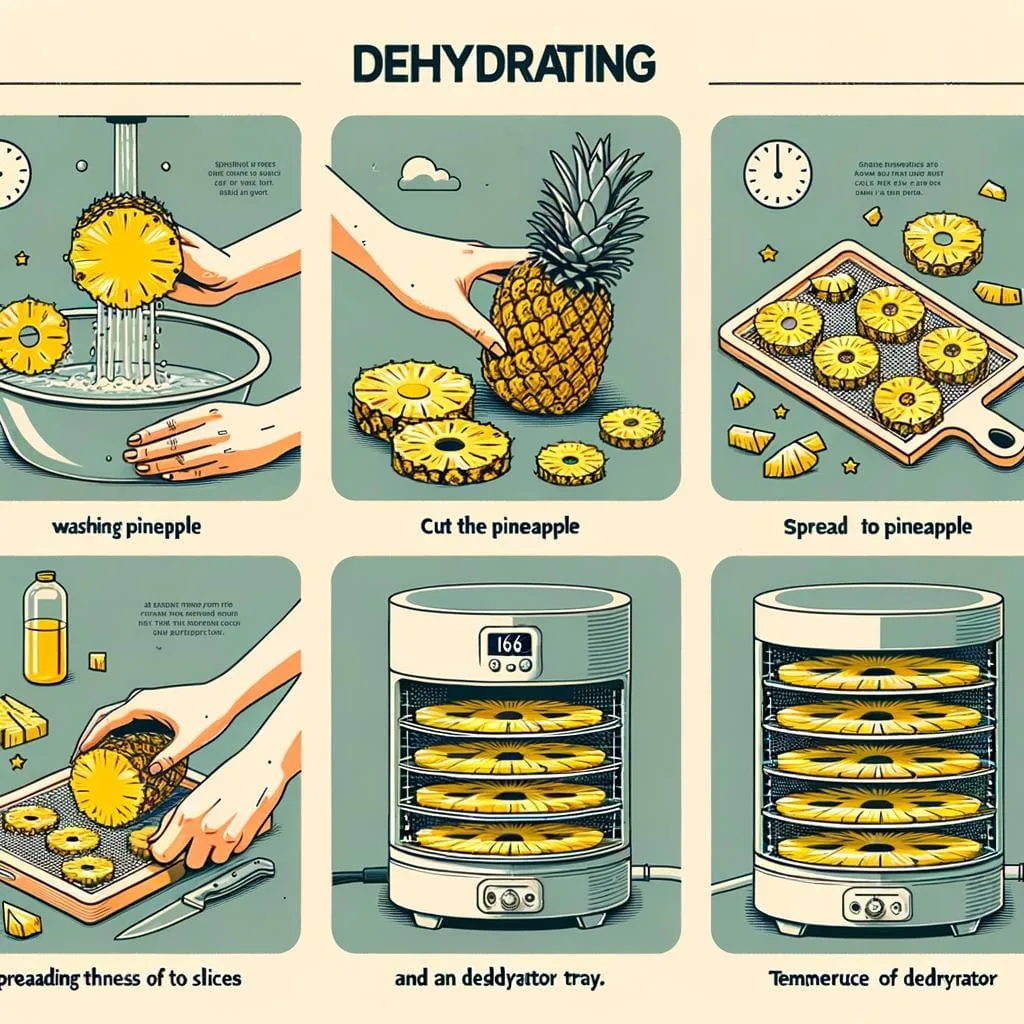Dehydrating pineapple is a great way to extend the shelf life of the fruit and make it easier to transport and store. It can also be used as a flavorful snack or as an ingredient in recipes. But how long does it take to dehydrate pineapple? The answer depends on the type of dehydration method used, the size of the pieces, and other factors. In this article, we’ll discuss these factors and provide an estimated dehydration time for different types of pineapple.It typically takes around 4-6 hours to dehydrate pineapple. However, the exact amount of time will depend on the thickness of the pineapple slices and the temperature and humidity of the dehydrator.
Preparing Pineapple for Dehydrating
Preparing pineapple for dehydrating is a simple process that requires minimal effort. The first step is to clean the pineapple, making sure it is free of dirt and debris. Once it’s cleaned, you will need to cut the pineapple into small pieces or slices, depending on how you want to dehydrate it. The smaller the pieces, the quicker they will dehydrate. Make sure the pieces are uniform in size for even dehydration.
After cutting your pineapple, you can either blanch or marinate it before dehydrating. Blanching involves quickly submerging your pineapple pieces in boiling water for a few minutes before removing them and plunging them into an ice bath. This helps preserve color and flavor as well as kill any bacteria that may be present on the fruit. Marinating involves soaking your pineapple pieces in a mixture of lime juice and sugar for at least an hour before dehydrating them. This will give them a sweet flavor and help prevent discoloration during dehydration.
Once you have prepped your pineapple, you are ready to begin dehydrating. Place the slices on a tray with parchment paper or silicone mats to prevent sticking and place them in your dehydrator according to manufacturer instructions. Dehydrate at 135°F (57°C) until they are crispy and leathery but not brittle or burned – this should take about 6-8 hours depending on thickness of pieces. Once done, allow your pineapple slices to cool completely before storing in an airtight container or freezing for later use.
The Benefits of Dehydrated Pineapple
Dehydrated pineapple is an incredibly nutritious and tasty snack that is beneficial to your health. It is a great source of vitamins, minerals, and fiber, and can help you meet your daily dietary needs. It also has a long shelf life, making it an excellent choice for snacks and meals on the go. Here are some of the benefits of dehydrated pineapple:
• Rich in Vitamins & Minerals: Dehydrated pineapple is high in vitamin C, which helps boost your immune system, as well as potassium and magnesium. These vitamins and minerals are essential for overall health and well-being.
• High in Fiber: Dehydrated pineapple is a good source of dietary fiber, which helps keep your digestive system healthy and functioning properly. Fiber also helps you feel fuller for longer periods of time, which can help with weight management.
• Low in Calories: Dehydrated pineapple contains very few calories compared to fresh pineapple. This makes it a great snack option for those who are watching their caloric intake.
• Long Shelf Life: Dehydrated pineapple has a much longer shelf life than fresh pineapple. This makes it perfect for stocking up on snacks or meals that you can take with you when you’re on the go.
Overall, dehydrated pineapple is an excellent snack option that provides numerous health benefits. It’s low in calories, high in fiber, and rich in essential vitamins and minerals. Plus, its long shelf life makes it an ideal choice for those looking to stock up on snacks or meals when they’re on the go.
What Equipment Do You Need To Dehydrate Pineapple?
Dehydrating pineapple is a great way to preserve the sweet, juicy fruit, allowing you to enjoy it year-round. To dehydrate pineapple, you need some specialized equipment. The most important piece of equipment you need is a dehydrator. This device uses heat and air circulation to dry out food without cooking it. It’s important to get a dehydrator that is specifically designed for drying food, as other types of dehydrators may not produce the desired results.
You will also need air-tight containers in which to store your dried pineapple once it is finished. Mason jars or vacuum-sealed bags are ideal options, as they will keep the dried pineapple free from moisture and help preserve its flavor and texture. Additionally, you will need kitchen shears or a sharp knife for cutting the pineapple into slices or chunks before dehydrating it.
Finally, it’s helpful to have some parchment paper on hand when dehydrating pineapple. The paper can be used to line the trays of your dehydrator, preventing the pieces of fruit from sticking and making cleanup easier when you’re done. With these supplies in hand, you’re ready to start dehydrating your delicious pineapple!
Choosing the Best Pineapples for Dehydrating
When it comes to dehydrating pineapples, it is important to choose the right variety. There are different types of pineapples available, each with its own unique flavor and texture. The most common varieties of pineapple include Smooth Cayenne, Hawaiian Red, Queen, and Golden. All of these types can be successfully dehydrated, but some work better than others depending on the desired outcome. Here are some tips for selecting the best pineapple for dehydrating.
Smooth Cayenne is the most popular variety when it comes to dehydrating pineapples. This type has a sweet, mild flavor and a smooth texture that makes it easy to cut into thin slices. It also retains its shape during the dehydration process, which makes it a great choice for making chips or other snack foods. Hawaiian Red is similar in flavor and texture to Smooth Cayenne but has a slightly firmer texture. This type works best when dehydrated in larger pieces because of its tendency to discolor when cut into thin slices.
Queen pineapples have a sweeter taste than other varieties and are often preferred by those who enjoy eating them fresh or in juices or smoothies. They can be successfully dehydrated as well, but they tend to lose their shape more easily than other types so it is best to cut them into smaller pieces before drying them. Golden pineapples have a very sweet tropical flavor that is enhanced during dehydration and make great snacks or desserts when dried properly.
When selecting a pineapple for dehydration, it is important to look for one that is ripe but not overripe. Overripe pineapples will be soft and have an off-putting sour taste when dried while underripe ones will not dry properly. Look for ones that have bright yellow skin with no green patches and feel firm but not hard when squeezed gently.
Finally, always make sure to choose organic pineapples whenever possible since they tend to contain fewer chemicals and pesticides than conventional varieties. By following these tips you can ensure that you select the best variety of pineapple for your dehydration projects!

Pre-Treating the Pineapple Before Dehydrating
Dehydrating pineapples is a great way to enjoy the sweet and tangy fruit year-round. However, in order to ensure that you get the best taste out of your dried pineapple, it is important to pre-treat it before dehydrating. This process will help to lock in the flavor and prevent any discoloration. Here are some tips for pre-treating pineapple before dehydrating:
The first step is to wash the pineapple thoroughly with cold water. This will help remove any dirt or bacteria that may be present on the skin. It is also important to remove any remaining leaves or stems from the pineapple before proceeding.
Once the pineapple has been washed, it should be sliced into thin slices or cubes. The thinner the slices, the quicker they will dry in the dehydrator. It is also important to ensure that all of the slices are cut evenly in order for them to dry uniformly.
Next, it is important to coat each piece of pineapple with an acidic solution such as lemon juice or vinegar. This helps to preserve the color of the pineapple while also preventing any oxidation from occurring during drying. Letting each piece sit for a few minutes before placing them in a dehydrator will give them ample time for this solution to take effect.
Finally, place all of your prepared pieces into a dehydrator and set it according to your machine’s instructions. Depending on how thin your slices were cut, this process can take anywhere from 8-14 hours. Once finished, you can enjoy your sweet and tangy dried pineapple!
Step 1: Preparing the Pineapple
The first step in dehydrating pineapple is to prepare the fruit. Start by washing the pineapple and then slicing it into thin rounds or chunks. Peel the skin off of each slice, and then remove the core from each slice as well. The thinner the slices, the faster they will dehydrate later on. If you are making chunks, make sure they are all roughly the same size so that they dry evenly.
Step 2: Applying Salt
Once all of your pineapple slices or chunks are prepared, you can add a light coating of salt to them. Salt helps to preserve the fruit and enhance its flavor during dehydration. Make sure to evenly distribute it among all of your pieces before proceeding.
Step 3: Drying
After applying salt, you can place your pineapple slices or pieces on a dehydrator tray. If you don’t have a dehydrator, you can also use an oven set at its lowest temperature setting. Leave your pineapple in for about 8 hours or until it is completely dried out and crispy.
Step 4: Storing
Once your pineapple is finished dehydrating, you can store it in an airtight container in a cool and dry place. Dehydrated pineapple will stay fresh for up to six months when stored properly. Enjoy as a snack or use as an ingredient in recipes!
Choosing the Right Fruit
When dehydrating pineapple, it’s important to select fruit that is ripe but not overripe. Overripe pineapple will be too soft and mushy to dehydrate properly and will produce an unsatisfactory product. Look for fruits that are yellow in color with a firm texture and no brown spots. Avoid any fruit that has soft spots or shows signs of decay.
Cleaning and Preparing the Fruit
Before dehydrating pineapple, it’s important to thoroughly wash the fruit in cold water to remove any dirt or debris. Peel the pineapple, then cut it into slices that are no thicker than 1/4 inch. This will help ensure that all pieces of the fruit dry evenly. Use a sharp knife or a mandoline slicer for best results.
Dehydrating the Pineapple
Once the pineapple is prepared, place the slices on a mesh tray and set the temperature setting on your dehydrator between 135-145°F (57-63°C). Dehydrate for 8-12 hours, flipping the slices halfway through if necessary. The finished product should have a chewy texture with deep golden brown color. If desired, sprinkle some sugar onto each slice before placing in the dehydrator for added sweetness.
Storing Dehydrated Pineapple
Once fully dried, store your dehydrated pineapple in an airtight container at room temperature for up to 6 months. To extend its shelf life further, store in a cool dry place away from direct sunlight or heat sources such as ovens and radiators. Be sure to check for signs of mold before consuming any stored fruit as this can be dangerous if ingested.
By following these simple tips, you can ensure that your dried pineapple is of the highest quality and taste great when eaten!

Conclusion
Dehydrating pineapple is a simple and easy process that takes two or three hours of your time. The results are well worth the effort, as you get delicious, sweet, and healthy snacks that can be stored for a longer period of time. You can also use the dried pineapple pieces in salads, trail mixes, baked goods, and other recipes. Dehydrating pineapple does not require any special skills or expensive equipment. All you need is a dehydrator, fresh pineapple, and a bit of patience.
Overall, dehydrating pineapple is an enjoyable experience that will give you tasty snacks to enjoy for weeks to come. With its natural sweetness and nutrients preserved in the dehydration process, pineapple is an excellent choice for making healthy snacks at home. Give it a try today!



